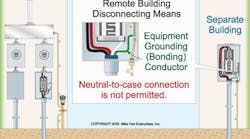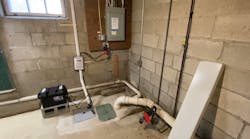(A) Grounding Electrode. To provide a path to earth for lightning, each building or structure must have its disconnecting means [225.31] grounded (earthed) to one of the following electrodes [250.50 and 250.52(A)]:
- Underground metal water pipe [250.52(A)(1)]
- Metal frame of the building or structure [250.52(A)(2)]
- Concrete-encased steel [250(A)(3)]
- Ground ring [250.52(A)(4)]
- Ground rod [250.52(A)(5)]
- Metal underground systems [250.52(A)(7)]
Bonding Requirements. To quickly clear a ground fault and remove dangerous voltage from metal parts, the building or structure disconnecting means must be grounded (bonded) to an effective ground-fault current path in accordance with (1) or (2) [250.4(A)(3)].
(1) Equipment Grounding (Bonding) Conductor. The building or structure disconnecting means can be bonded to an equipment grounding (bonding) conductor, as described in 250.118, installed with the feeder conductors. The equipment grounding (bonding) conductor, if of the wire type, must be sized in accordance with 250.122, based on the rating of the feeder protection device.
Caution: To prevent dangerous objectionable current from flowing onto metal parts of the electrical installation, as well as metal piping and structural steel [250.6(A)], a building or structure disconnecting means supplied by a feeder must not have the grounded neutral conductor bonded to the building or structure disconnecting means. <>
(2) Grounded Neutral Conductor. When an equipment grounding (bonding) conductor is not run to the building or structure disconnecting means, the building or structure disconnecting means can be bonded to a grounded neutral conductor installed with the feeder conductors. This is only permitted where there’s no continuous metallic path between buildings and structures, and ground-fault protection of equipment isn’t installed on the supply side of the feeder.
Where the grounded neutral feeder conductor serves as the effective ground-fault current path, it must be sized no smaller than the larger of:
(1) The maximum unbalanced neutral load in accordance with 220.61.
(2) The available fault current in accordance with 250.122.
Caution: Using the grounded neutral conductor as the effective ground-fault current path poses potentially dangerous consequences and should only be done after careful consideration. Even if the initial installation doesn’t result in dangerous objectionable current on metal parts, there remains the possibility that a future installation of metal piping or cables between the buildings or structures could create unwanted parallel neutral current paths.
My preferred practice is to not use the grounded neutral conductor as the effective ground-fault current path, but to install an equipment grounding (bonding) conductor with the feeder conductors to the building or structure in accordance with 250.32(B)(1).
(E) Grounding Electrode Conductor. The grounding electrode conductor for a separate building or structure disconnecting means must terminate to the grounding terminal of the disconnecting means, and it must be sized in accordance with 250.66, based on the largest ungrounded feeder conductor.
Where the grounding electrode conductor is connected to a ground rod, that portion of the conductor that is the sole connection to the ground rod isn’t required to be larger than 6 AWG copper [250.66(A)]. Where the grounding electrode conductor is connected to a concrete-encased electrode, that portion of the conductor that is the sole connection to the concrete-encased electrode isn’t required to be larger than 4 AWG copper [250.66(B)].
Editor’s note: This information was extracted from Mike Holt’s textbook, Understanding the National Electrical Code.





